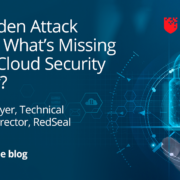The Hidden Attack Surface: What’s Missing in Your Cloud Security Strategy?
It happens all the time. A company has the right security policies in place but misconfigures the environment. They think they are protected. Everything looks fine. They locked the doors and boarded up the windows to the room where the crown jewels are kept, but nobody noticed that the safe that holds the jewels is no longer in that room. Accidentally, it was moved to another location, which is left wide open.
Here’s another common scenario. When working in the cloud, someone in your company can easily turn on a policy that allows anyone to gain access to your critical resources. Or, maybe you grant temporary access to a vendor for maintenance or troubleshooting but then forget to revoke the access. There may be legitimate reasons to grant access, but if that resource is compromised, your cloud can be infected.
Cloud Environments Are Constantly Evolving and Easy to Misconfigure
The challenge in today’s cloud environment is that things are never static. Things are spinning up constantly, new endpoints are being added, and new connections are being made. Cloud users can easily misconfigure or forget to revoke access to critical resources. So you lock the front door and think you’re safe when the back door might be open or someone is opening and closing new windows all the time.
Nearly seven in 10 organizations report dealing with cyberattacks from the exploitation of an unknown or unmanaged asset connected to the internet. With today’s complex cloud, multi-cloud, and hybrid cloud environments, uncovering the hidden attack surface is crucial to uncover every potential resource that could be compromised.
What is the Hidden Attack Surface?
Uncovering the hidden attack surface involves knowing all unknown resources in your cloud and finding all attack paths to the resources – not just the most likely paths like most CNAPP/CSPM vendors. Finding all attack paths requires deep intelligence to map the full cloud network and determine every potential exposure point.
Cybercriminals are constantly looking for pathways, or hidden attack paths, to get to your crown jewels. With today’s emphasis on cybersecurity, companies rarely leave the front door open to let hackers walk right in. But there may be vulnerabilities that do allow access and then a pathway to reach the jewels. It may be a twisted and convoluted path, but it gets hackers where they want to go.
An attack path analysis details every endpoint and connection to show how threat actors could enter your house and travel the path to find what they’re looking for. By highlighting every possible path and policy detail associated with these pathways, you gain comprehensive visibility into your network.
This information details the traffic that can enter or exit a hop on the attack path and what controls are enabling them to uncover areas of unintended access to critical cloud resources.
Mapping the Entire Infrastructure
Some other solutions are also inadequate to map the entire infrastructure.
Let’s say you have someone conducting penetration testing. Pen testing focuses on the major attack points but doesn’t identify every single way, inside out, to connect to those resources. Think of it this way: You want to drive from San Jose to San Francisco. Nearly everyone making that drive will use the 101 or 280. But 880 can also connect, and there are thousands of side routes that you could use to make the ride. It may take a long time, but you’ll ultimately get to your destination.
Pen tests focus on the most typical routes. Plus, routes are constantly changing. They don’t take into account that new subdivision that didn’t exist last week that allows through traffic. You may segment your data, but new pathways evolve that suddenly allow lateral movement. Without real-time attack path analysis, you may be secure one moment and insecure the next.
Not All Attack Path Analysis Vendors Work the Same Way
When looking to analyze attack paths, it’s crucial to choose the right vendor. Not everyone approaches attack path analysis the same way, and the wrong solution may give you a false sense of security.
Just like penetration testing, most CNAPP/CSPM companies focus on the same major pathways. For example, if you’re using AWS and want to know which resources may be exposed, most vendors will check AWS security groups, AWS network access control lists (NACL), and AWS gateways. But are they also checking gateways such as AWS Transit Gateways, Third Party Firewalls, Load Balancers and all other cloud networking resources.
Effective security demands that you view everything end-to-end including every endpoint, pathway, and policy. While you may start with the obvious paths, it’s not enough. Attackers know that the most obvious spots are usually protected, so they’re constantly probing for the path that’s not so obvious and less likely to be guarded. This is uncovering the hidden attack surface that results in most cloud security breaches.
Comprehensive Attack Path Analysis with RedSeal
RedSeal uncovers the hidden attack surface by providing a comprehensive attack path analysis of every possible entry point and pathway within your infrastructure to determine what resources may be exposed. Besides end-to-end mapping, RedSeal also shows you how the exposure occurred and provides remediation guidance.
You get:
- A list of all resources, subnets, and instances that are deemed critical, grouped by AWS accounts, Azure subscriptions, AWS VPCs, Azure VNETs, tags, and subnets
- Specific ports, protocols, and services that are open and exposed — e.g., HTTPS (443), SSH/TCP (22), SMTP/TCP (25), RDP with exposure details
- Full attack path analysis to critical resources, highlighting all possible paths and the security policy details associated with each path
- Details about what and where traffic can enter, what controls are enabling entry, and the paths attackers can take once they gain entrance
You can complement your cloud service provider’s operational tools by getting a real-time evaluation of all affected resources across multiple cloud environments. Using an agent-less, API-based approach, RedSeal Stratus uncovers all resources deployed within your environment and lets you view them in a single pane of glass.
Not only do you get a comprehensive view of your cloud infrastructure and insight into potential exposure points, but you also get a roadmap for remediation. Stratus identifies and calculates every possible path, port, and protocol — not just active traffic — to help you prioritize your remediation efforts. Security teams can then perform root cause analysis and raise a remediation ticket for resource groups that may be impacted by security policies.
This ticket would include information about the affected resources, verification, remediation steps, and the potential risk if they are not mitigated.
RedSeal mitigates exposure with:
- Out-of-the-box (OOTB) reporting
- Simple, agent-less deployment
- Continuous risk assessment
- Drill-down capabilities with remediation guidance
- Seamless integration with ticketing and remediation systems like Jira
RedSeal’s cloud security solutions can bring all multi-cloud environments into one comprehensive, dynamic visualization and know the unknowns. This allows you to protect your cloud, conform to best practices and gain continuous monitoring for compliance.
Learn more by downloading our Solution Brief: Stop Unintended Exposure.


